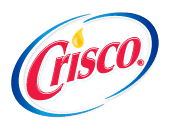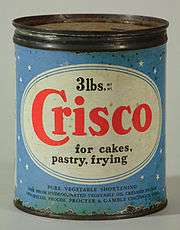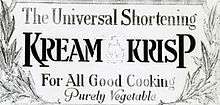Crisco



Crisco is a brand of shortening produced by The J.M. Smucker Company popular in the United States. Introduced in June 1911[1] by Procter & Gamble, it was the first shortening to be made entirely of vegetable oil. Additional products marketed by Smucker under the Crisco brand include a cooking spray, various olive oils, and other cooking oils, including canola, corn, peanut, olive, sunflower, vegetable and blended oils.
History
Hydrogenation of organic substances in gas form was discovered by Paul Sabatier in the late 19th century and hydrogenation while in liquid form was patented by Wilhelm Normann in 1903.[1] Procter & Gamble's business manager John Burchenal was contacted by and hired chemist Edwin C. Kayser, former chemist for Joseph Crosfield and Sons (who had acquired Normann's patent so as to produce soap), who patented two processes to hydrogenate cottonseed oil,[1] which ensures the fat remains solid at normal storage temperatures. Their initial intent was to completely harden oils for use as raw material for making soap.[1] After rejecting the names "Krispo" and "Cryst" (the latter for obvious religious connotations), the product was eventually called Crisco, a modification of the phrase "crystallized cottonseed oil".[1]
Further success came from the marketing technique of giving away free cookbooks with every recipe calling for Crisco. Crisco vegetable oil was introduced in 1960. In 1976, Procter & Gamble introduced sunflower oil under the trade name Puritan Oil, which was marketed as a lower-cholesterol alternative. In 1988, Puritan Oil became 100% canola oil.
Procter & Gamble divested the Crisco (oil and shortening) brand (along with Jif peanut butter) in a spinoff to their stockholders, followed by an immediate merger with the J. M. Smucker Co. in 2002.[2]
Changes in fat content
In April 2004, Smucker introduced "Crisco Zero Grams Trans Fat Per Serving All-Vegetable Shortening," which contained fully hydrogenated palm oil blended with liquid vegetable oils to yield a shortening much like the original Crisco. From January 24, 2007, all Crisco shortening products were reformulated to contain less than one gram of trans fat per serving; the separately marketed trans-fat free version introduced in 2004 was consequently discontinued.[3] As of 2012, Crisco consists of a blend of soybean oil, fully hydrogenated palm oil, and partially hydrogenated palm and soybean oils. According to the product information label, one 12 g serving of Crisco contains 3 g of saturated fat, 0 g of trans fat, 6 g of polyunsaturated fat, and 2.5 g of monounsaturated fat.[4] It is claimed that this reformulated Crisco has the same cooking properties and flavor as the original version of the product.
According to the FDA, "Food manufacturers are allowed to list amounts of trans fat with less than 0.5 gram (1/2 g) per serving as 0 (zero) on the Nutrition Facts panel."[5]
Some nutritionists argue that while the formula has been changed to remove the trans fatty acids, the fully hydrogenated oil used to replace them may not be good for health. Crisco and similar low-trans-fat products are formed by the interesterification of a mixture of fully hydrogenated oils and partially hydrogenated oils. The composition of the resultant triglycerides is random, and may contain combinations of fatty acids not commonly found in nature.[6][7] A recent study showed that interesterified fat increased volunteers' blood sugar by 20 percent while simultaneously lowering the body's HDL cholesterol.[8]
Kream Krisp

While Kayser's patents were filed in 1910 and granted in 1915, with Crisco appearing on the market in 1911, Hugh Moore, chief chemist for the Berlin Mills Company in Berlin, New Hampshire, filed his patents by 1914 and they were granted in 1914 and 1916, with the vegetable shortening later trademarked in 1915 as Kream Krisp appearing on the market in 1914.[1] Procter & Gamble became aware of the competition by February 1915 and Burchenal contacted Berlin Mills claiming that they were infringing on P&G's patents and suggesting they meet to discuss the issue. When this failed P&G filed suit against Berlin Mills, the litigation being known as Procter and Gamble vs. the Brown Company (Berlin Mills Co. v. Procter & Gamble Co., 254 U.S. 156 (1920)), since in 1917 the Berlin Mills Co. became the Brown Company.[1] Procter and Gamble lost the suit but in the mid-1920s, Kream Krisp was sold to them, and Crisco was reintroduced to the market.[9]
References
- 1 2 3 4 5 6 7 Jackson & List (2007). "Giants of the Past: The Battle Over Hydrogenation (1903–1920)", Inform 18.
- ↑ "J.M. Smucker announces stock deal with P&G for JIF and Crisco: Smucker combines three #1 classic food brands". Smuckers.com. October 10, 2001. Archived from the original on Oct 28, 2007.
- ↑ "Frequently Asked Questions: I can't find the Crisco green can anywhere". Crisco.com. Archived from the original on Feb 18, 2008.
- ↑ Product info, at Crisco.com
- ↑ FDA website
- ↑ Alex Renton (27 September 2006). "Alex Renton investigates the health risks of trans fats: Grease is the word". The Guardian.
- ↑ David B. Min. "Unit FST 821: Food Lipids; Lecture notes: Interesterification" (PDF). Ohio State University.
- ↑ "New Fat, Same Old Problem With An Added Twist? Replacement For Trans Fat Raises Blood Sugar In Humans". Science Daily. January 2007.
- ↑ "Brown Paper Company" (PDF). Retrieved July 15, 2012.
See also
External links
- Official website
- Official gazette of the United States Patent Office, Volume 253
- Planet Money: Who Killed Lard